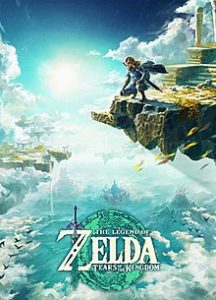 For Father’s Day, I got an unexpected gift, Legend of Zelda: Tears of the Kingdom for the Switch. And for my birthday a month later, I received Breath of the Wild.
For Father’s Day, I got an unexpected gift, Legend of Zelda: Tears of the Kingdom for the Switch. And for my birthday a month later, I received Breath of the Wild.
I’ve always enjoyed The Legend of Zelda series. Back in the late 80’s, the only opportunity I had to play it was when I was visiting my cousin’s who owned a NES. (They also had an Atari 2600 which was the only time I could play THOSE games as well.) We finally got our own NES for Christmas in 1990, so shortly after I played and won both of the first two games. And later I bought, played, and won Link to the Past on the SNES.
Then I had a long break, until I was in my 2nd stint of college pursing my C.S. degree and I saw someone playing Wind Waker. Unlike many of the time, I loved the cartoonish look of the graphics and I bought a GameCube just to play it. It remains my favorite Zelda of all time. (And I am SUPER annoyed it has not been made available on the Switch.)
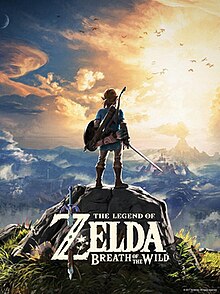 I also got a copy of Ocarina of Time for the GameCube, which I played about halfway before losing interest. When Twilight Princess was announced, I was annoyed that they groveled to the haters and promised the game would have an “adult” look, and so I skipped that one and left the series behind, until now. (I may dig around for a GameCube version of Twilight Princess, if I can find one cheap.)
I also got a copy of Ocarina of Time for the GameCube, which I played about halfway before losing interest. When Twilight Princess was announced, I was annoyed that they groveled to the haters and promised the game would have an “adult” look, and so I skipped that one and left the series behind, until now. (I may dig around for a GameCube version of Twilight Princess, if I can find one cheap.)
So, I’m in a unique position to review the Zelda titles on the Switch, as I started with Tears of the Kingdom and then played Breath of the Wild afterwards. Just to be clear: Both are EXCELLENT games, and well worth playing. The details on that follow.
Gameplay
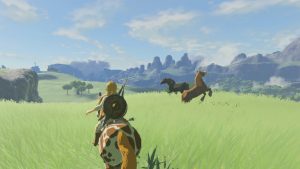
The descriptions you hear the most about both of these games is “open world” and this is absolutely true. After you have left the tutorial area of each game, you are literally left on your own to go anywhere you can reach. And the “dungeons” in each game can be done in any order, although some are easier than others.
Both games feature “shrines” which act as a means to increase your health and stamina and provide means for fast travel. Neither game lets you max out both hearts and stamina; you have to choose the balance you want. In Tears of the Kingdom I found stamina slightly more valuable to have, so I maxed that one out over heart containers.
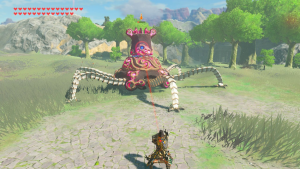 Both titles embrace what I like to call “the Dark Souls model” of action game-play. Namely, you’re expected to watch and observe your enemies in combat and time correctly your attacks and defenses. As Wind Waker was my last Zelda, I was unprepared for this. I spent most of my time just hacking away ignoring tells and getting knocked down or hurt, because I was expecting to be told WHEN to push a button to defend. If I had started with Breath of the Wild I’d have learned this lesson sooner, as some combats can only be successful there if you time defenses right. (Namely, deflecting Guardian laser blasts.)
Both titles embrace what I like to call “the Dark Souls model” of action game-play. Namely, you’re expected to watch and observe your enemies in combat and time correctly your attacks and defenses. As Wind Waker was my last Zelda, I was unprepared for this. I spent most of my time just hacking away ignoring tells and getting knocked down or hurt, because I was expecting to be told WHEN to push a button to defend. If I had started with Breath of the Wild I’d have learned this lesson sooner, as some combats can only be successful there if you time defenses right. (Namely, deflecting Guardian laser blasts.)
Both games also leave behind the “gimmick tool” approach that was used in prior Zelda’s. You’d always get a special “tool” like the boomerang or the grappling hook in a given dungeon that then was the key to defeating the dungeon’s boss. If anything, these games largely diminish the value of the boomerang; I almost never used it in either game via throwing because it just wasn’t worth the effort.
Both games introduce equipment decay, Tears of the Kingdom goes further by having most weapons being covered in gloom and even more brittle than usual. This is an interesting concept, as it requires you to have a steady supply of replacements always available, and it keeps combat interesting. The Master Sword in both games doesn’t break, it just runs out of energy and requires a real-time recharge wait to reuse. I’m not sure it’s a system they should return to in a sequel as by the time I finished both games I was done with it.
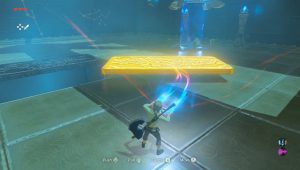 Both games have “special” abilities, in Breath of the Wild provided by your Sheikah Slate (which gee, looks EXACTLY like a Wii U or a Switch Lite) and in Tears of the Kingdom by your replacement right arm. Of the two, Tears of the Kingdom clearly benefited from a lot of feedback. The Sheikah abilities are a little clunky in comparison. And despite the fact it offered unlimited bombs, I actually liked that Tears of the Kingdom returned the bomb flower of older games.
Both games have “special” abilities, in Breath of the Wild provided by your Sheikah Slate (which gee, looks EXACTLY like a Wii U or a Switch Lite) and in Tears of the Kingdom by your replacement right arm. Of the two, Tears of the Kingdom clearly benefited from a lot of feedback. The Sheikah abilities are a little clunky in comparison. And despite the fact it offered unlimited bombs, I actually liked that Tears of the Kingdom returned the bomb flower of older games.
A big selling point of Tears of the Kingdom was their physics engine. And it is VERY good. I could tell Breath of the Wild is just “faking” the physics in various puzzles. Combined with the ability to build and assemble machines, it gives the game a huge amount of flexibility to puzzle solving and even travel.
Both games feature an interesting method of replenishing monster encounters. A “blood moon” rises every couple real-time hours of play that regenerates monsters all over the game. You can’t force it to happen, as it tracks to real-time play. But if you are trying to farm specific creatures (Particularly in Tears of the Kingdom, when you need material components) it helps you know when you can hit certain spots again.
One minor complaint about both games I have is the increase in power for monsters. Each monster type has four variants, each one with more hit points. The strongest are the “silver” variety, and their hit points are just ludicrously high. After a certain point silvers can re-spawn anywhere in game, which means you end up with very lopsided fights where you kill most of the enemies in one blow but end up in a grind on the last one or two. Knocking them into water is one of the best tactics as no matter how strong they are they drown almost immediately. (Doesn’t work with Lizafos, who can swim.)
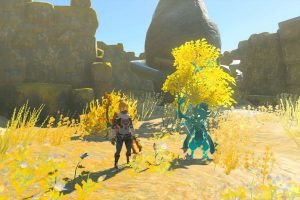 In Tears of the Kingdom, you gain the aid of the various sages who then have an “avatar” that you can summon that will fight with you. This makes the game easier but also a bit frustrating. The AI for them is maddeningly stupid at times; I can’t count how often I’ve seen them approach an enemy but NOT attack. Probably their best feature is drawing attention. When fighting Lynels, they often distract or redirect his targeting to them, which is very useful. The best of them is Tulin, the Rito archer, he does seem to hit often with his bow at the right moment.
In Tears of the Kingdom, you gain the aid of the various sages who then have an “avatar” that you can summon that will fight with you. This makes the game easier but also a bit frustrating. The AI for them is maddeningly stupid at times; I can’t count how often I’ve seen them approach an enemy but NOT attack. Probably their best feature is drawing attention. When fighting Lynels, they often distract or redirect his targeting to them, which is very useful. The best of them is Tulin, the Rito archer, he does seem to hit often with his bow at the right moment.
Both games feature an elaborate “cooking” system, by which you can create food and elixirs that give temporary ability boosts as well as recover hearts. I never experimented a lot with this, but I could see a younger version of myself really getting into that. I do like the fact that Link just recovers all his health with a good night’s sleep. Past games were harsh on heart recovery methods.
Rupees, or money, is not easy to come by in either title. The only enemies who drop money are the Yiga clan; monsters only drop weapons, shields, and materials. There are mini-games you can win money at, and you can sell materials and crafted food/elixirs. So it’s not too bad. The biggest challenge is not accidentally selling something you need for armor upgrades.
Tears of the Kingdom has a LOT more stuff than Breath of the Wild. In fact, it’s almost too much. You need material components to upgrade armor at the Great Fairies, and you may spend a lot of time hunting and farming very specific things. It also has more monster types, which drop unique materials for the level of the creature. This plays into your Fuse ability which lets you fuse monster horns, claws, etc. onto weapons to increase their attack power. You can also find unblemished weapons in the Depths, held by what I presume is shadowed spirit of a lost hero.
Breath of the Wild also has DLC content, which adds additional armors to the game and a challenging “Champions Trial”. I found the DLC content to be incredibly difficult; too much so. It starts with you using a special weapon that can kill anything in one hit, but drains you to a quarter-heart so a single hit can kill you. You then have to eliminate four camps of monsters with this limitation (thank goodness it lets you use your bow!) and solve shrines that are ludicrously hard with deathtraps everywhere.
After you’ve done this it sets up three additional shrines in the four main regions of the divine beasts that you must uncover and solve. Once that’s done, you can approach the divine beast and are forced to fight the bosses of each again, but this time in a strange “dream” realm using the weapons the original pilot used. It’s clearly meant as a metaphor; they lost their fights a century ago and now Link is fighting and winning them. Again, far too difficult. But after winning each sage’s powers recover twice as fast, which makes it worth it.
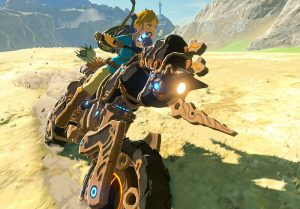 The final trial is another divine beast dungeon, at the end of which you fight one of the ancient monks that are in the shrines everywhere. He fights using the various Yiga clan techniques, and is, not surprisingly, very hard. But if you win, you get your own “divine beast” which is, wait for it… a motorcycle. 🙂 By the time I got this I didn’t need to go cruising around Hyrule, but it’s pretty cool.
The final trial is another divine beast dungeon, at the end of which you fight one of the ancient monks that are in the shrines everywhere. He fights using the various Yiga clan techniques, and is, not surprisingly, very hard. But if you win, you get your own “divine beast” which is, wait for it… a motorcycle. 🙂 By the time I got this I didn’t need to go cruising around Hyrule, but it’s pretty cool.
The other part of the DLC is the Trial of the Sword. Normally the Master Sword has a base attack power of 30, but in dungeons or the final end-game, it’s power is doubled to 60 and it’s indestructible. Completing the trial of the sword lets you raise the base power of the Master Sword by 10 for each trial completed, so that you could have the sword at maximum power at all times.
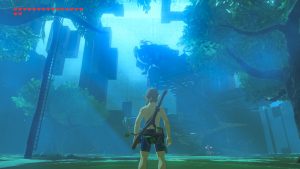 The problem? The trial is stupid difficult. You’re dropped into a dungeon with zero equipment, all of it has to be salvaged as you go. You have no access to sage abilities, only your sheikah slate powers. And if you die, you have to start over from the beginning. The problem with this trial is it’s SO hard, you pretty much have to already be maxed out on hearts to get through, but at that point in the game, having a maxed out Master Sword everywhere has very little value.
The problem? The trial is stupid difficult. You’re dropped into a dungeon with zero equipment, all of it has to be salvaged as you go. You have no access to sage abilities, only your sheikah slate powers. And if you die, you have to start over from the beginning. The problem with this trial is it’s SO hard, you pretty much have to already be maxed out on hearts to get through, but at that point in the game, having a maxed out Master Sword everywhere has very little value.
Story
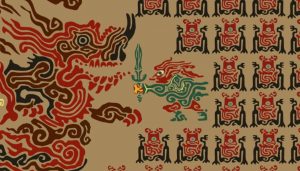
The Legend of Zelda has always been cyclic in nature. There is always a Princess Zelda, there is always a Link, and they are always fighting Ganon, in one form or another.
The interesting part of these two games is that they decided to embrace it, and make it part of the story. Essentially, Zelda is the mortal avatar of the goddess Hylia, who created everything. Ganon is a demon/fallen god who wanted her power, and also followed her into the mortal world to possess it. Link represents the mortal races, the ones who have the choice between good and evil. So this is why the battle between them happens over and over.
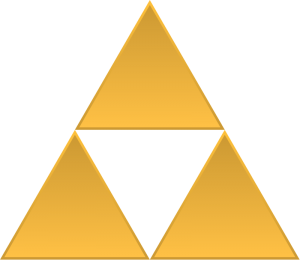 Interestingly, neither game features the Triforce, which was a prominent artifact of the older games. In fact, the last time we saw it was in Wind Waker, which is now considered a variant timeline. You can see the Triforce symbol in artwork and on the Master Sword itself, and there are springs of Power, Wisdom and Courage to be found, but the Triforce itself isn’t mentioned otherwise.
Interestingly, neither game features the Triforce, which was a prominent artifact of the older games. In fact, the last time we saw it was in Wind Waker, which is now considered a variant timeline. You can see the Triforce symbol in artwork and on the Master Sword itself, and there are springs of Power, Wisdom and Courage to be found, but the Triforce itself isn’t mentioned otherwise.
Both of these games are also set long after every prior Zelda game, and it’s been clearly established that the timeline has started anew from here. We probably won’t see any further “prequel” style games from here on out.
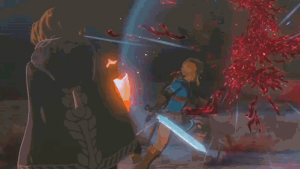 Since I started with Tears of the Kingdom, it was old hat for me to see Zelda and Link together, although I was a little disconcerted to see Link reduced to a shadow of his former self. It wasn’t until Breath of the Wild that I realized that Link and Zelda are both literally out of their time; the kingdom of Hyrule was more or less destroyed a century ago.
Since I started with Tears of the Kingdom, it was old hat for me to see Zelda and Link together, although I was a little disconcerted to see Link reduced to a shadow of his former self. It wasn’t until Breath of the Wild that I realized that Link and Zelda are both literally out of their time; the kingdom of Hyrule was more or less destroyed a century ago.
I liked that in Tears of the Kingdom there was sign of rebuilding and people everywhere; Breath of the Wild has far too many stark and empty landscapes for me. In fact, there’s really only two Hylian settlements and the Sheikah village in the game. Where did everyone go?
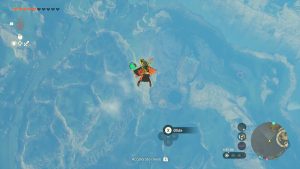 Because I started with Tears of the Kingdom, I spent a lot of time starting from the sky and floating down to various places to open up the map. As a result, I really didn’t get a feel for the landscape at all; it was all a chaotic jumble that I just used shrines to jump back and forth on. Breath of the Wild definitely grounds you (pun intended) and forces you to actually walk places and get a feel for the regions and areas.
Because I started with Tears of the Kingdom, I spent a lot of time starting from the sky and floating down to various places to open up the map. As a result, I really didn’t get a feel for the landscape at all; it was all a chaotic jumble that I just used shrines to jump back and forth on. Breath of the Wild definitely grounds you (pun intended) and forces you to actually walk places and get a feel for the regions and areas.
Since Tears of the Kingdom starts with Zelda and Link, I didn’t have all the background that had already gone on. So when I started Breath of the Wild it was an “ah ha!” moment; Link’s been in a bacta tank for a century which explains why he (and the player) are so unfamiliar with things.
Both games play out a very similar story. In Breath of the Wild you need to take control of the Divine Beasts back from Calamity Ganon, each of which are in a different region of Hyrule. After you’ve done this it’s a lot of side quests and building up your strength for the final battle in Hyrule Castle. In Tears of the Kingdom, after acquiring all your new abilities and literally falling back to the surface of Hyrule, you’re tasked with investigating “problems” in the same four regions.
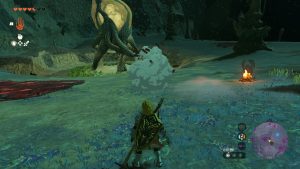 Tears of the Kingdom feels more like a classic Zelda game. It has true dungeons, it has caves, and Ganon is an actual person not just an elemental force. The boss battles for each dungeon feature a “giant” version of a normal monster, which is pretty cool. Each also requires a specific sage’s abilities to really fight effectively. The Depths are also very cool, a well done representation of an “Underdark”.
Tears of the Kingdom feels more like a classic Zelda game. It has true dungeons, it has caves, and Ganon is an actual person not just an elemental force. The boss battles for each dungeon feature a “giant” version of a normal monster, which is pretty cool. Each also requires a specific sage’s abilities to really fight effectively. The Depths are also very cool, a well done representation of an “Underdark”.
That’s not to say Breath of the Wild isn’t bad, it’s just weird that the only “dungeons” are giant gundams, er, divine beasts. The bosses are a weird mix of malice material and tech, and aren’t very distinctive from each other. Ganon is just a big clockwork spider thing which eventually manifests into a giant boar. It just feels like they deviated a bit too much from the base formula, and righted the ship with the sequel.
My main takeaway after finishing both games was, where do they go from here? It will definitely be on whatever future console Nintendo is developing, but are they going to continue the story of THIS Zelda and Link, or are they going to fast-forward again to the future and a new incarnation of everything? We’ll have to wait and see…

Notes
Here’s my list of miscellaneous notes and observations on both games.
- Both games really seem to like putting Link in a position where he’s running around in his underwear a lot. Even the end-game in Tears of the Kingdom removes his armor entirely.
- I like the fact that any “romance” between Zelda and Link is kept subtle and to the gamer’s imagination.
- On that note, more than a few NPC’s in the games are enamored of Link. Especially the Great Fairies.
- If I was shipping anyone with Link, it would be Purah! In Tears of the Kingdom, specifically.
- Calamity Ganon? Seriously? The english translator must have despaired to find a good match for whatever adjective was used in the original Japanese. Demon King works a lot better.
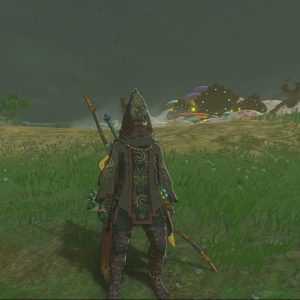 Did anyone consult a cultural advisor when it came to the Gloom resistant armor? A conical cap like that has some uncomfortable connotations in the USA…
Did anyone consult a cultural advisor when it came to the Gloom resistant armor? A conical cap like that has some uncomfortable connotations in the USA…- In Tears of the Kingdom, I never got a numerical report of monster hit points. But in Breath of the Wild I do… but inconsistently?
- Why aren’t you told the Master Sword’s base attack value in Tears of the Kingdom? Or it’s strength after you fuse material to it?
- It’s funny how both games feature advanced cultures (Sheikah, Zonai) who build machines. It definitely contributes to the feel that Tears of the Kingdom is just a redo of Breath of the Wild with more stuff.
- Where did all the shrines and towers of the Sheikah go between the two games? Did they dismantle them?
- Both games feature horses and fighting from horseback. That’s cool, but I almost never used them.
- The Master Sword was “The Blade of Evil’s Bane” in Wind Waker. Here it’s the “Sword that Seals the Darkness”. It went from being a relatively normal magic blade in Link to the Past to a full-fledged artifact.
- An interesting note is that Link only “kills” monsters, who vanish in purple/black smoke. If he fights Yiga clan members, they don’t actually die, they just retreat leaving spoils behind.
- I liked the preview of the Depths in Breath of the Wild with the “bottomless” chasm in the Yiga clan hideout, which Master Korgha falls into at the end of your battle with him. This explains how the Yiga clan has such a strong presence there later, and are familiar with Zonai technology.
- Korok seeds and inventory expansion was a lot easier in Tears of the Kingdom. It was way too much grinding in Breath of the Wild, I’m glad they reduced the overall number required to max out.
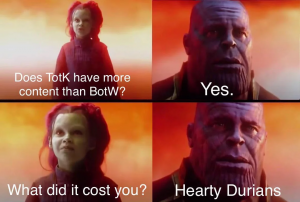 I was amused that Breath of the Wild had “hearty durians”. As anyone who watches the Food Network knows, this fruit has a… unique flavor and scent that is very much an acquired taste. But everyone loved it because cooking even a single one creates a meal that restores ALL hearts and gives temp hearts as well. It is conspicuously absent from Tears of the Kingdom.
I was amused that Breath of the Wild had “hearty durians”. As anyone who watches the Food Network knows, this fruit has a… unique flavor and scent that is very much an acquired taste. But everyone loved it because cooking even a single one creates a meal that restores ALL hearts and gives temp hearts as well. It is conspicuously absent from Tears of the Kingdom.- The Shrine puzzles are a lot more consistent and friendly to mistakes in Tears of the Kingdom. In particular, if a shrine has to be “created” from a fragment, you never have to solve a puzzle inside.
- I hated the “motion sensor” puzzles in Breath of the Wild. I use a detached controller to play and hook up my Switch to a TV. I have to keep the controller plugged into USB as the battery is bad/dead, so I couldn’t twist it in the proper directions easily. On some puzzles I ended up using the switch side controllers which were easier to manipulate. I’m glad they were not in Tears of the Kingdom.
- Man, Hyrule castle just can’t catch a break in either game…
- Love that Koroks have returned from Wind Waker! They were one of my favorite characters in that game.
- Love all the callback armors and weapons to prior Zelda’s. I think my favorite is the White Sword from the very first game.
- Didn’t like how in Breath of the Wild it tracks how many of certain items (like arrows) you have and won’t restock merchants until you drop under a certain number.
- Tears of the Kingdom in general seemed to have a lot more stuff in crates and barrels overall. It was a lot easier to stockpile various things.
- Lynels are hella-tough opponents! The memory cutscene of Link having just defeated several of them is total bull. It takes all your energy and focus to defeat just ONE.
- The Gloom hands are nasty… also another callback to Wind Waker, where they lacked the eyes but they could grab you and force you to restart the dungeon from the beginning.
- Ultrahand is by far the most awesome power in the game. I was seriously missing it in Breath of the Wild, when I was forced to roll boulders by force rather than just easily pick them up.
- Call me blind, but it wasn’t until I was nearly done with Tears of the Kingdom that I noticed that the light roots in the Depths align perfectly with the surface Shrines.
